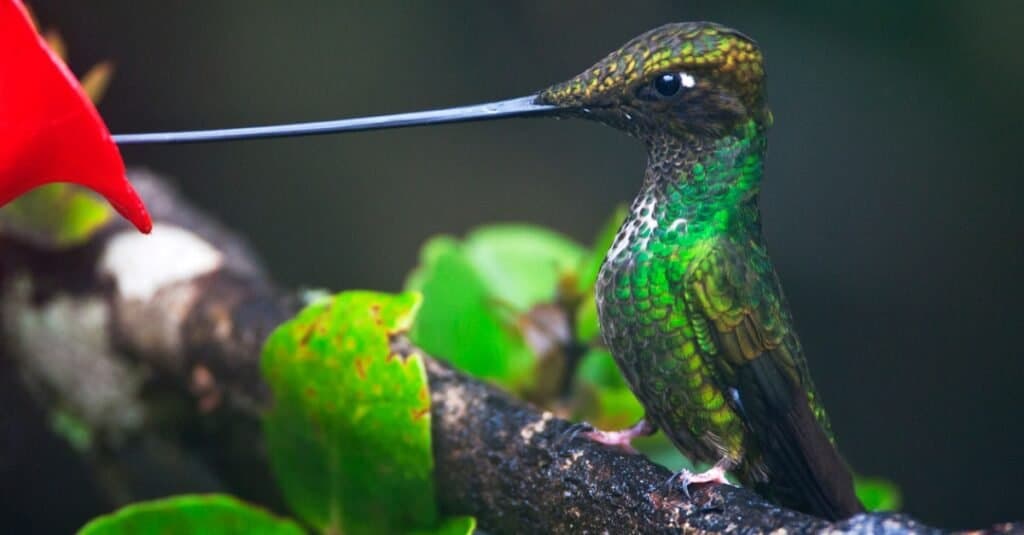Birds with Long Beaks- Top 10 Birds with Information
The shape and size of a bird’s beak can provide a person with an idea of the food it consumes and the method by which it captures what it consumes. Birds like cardinals have conical, strong bills that break open seeds and nuts. Birds of prey use hooked bills that tear up their food. Birds with short, sharp bills are typically insectivores. However, birds who have long, dagger-like bills are used for probing and impaling their prey whether that be reptiles, fish, or amphibians. Other species who evolved with bill lengths make use of them to enter blooms and seek out nectar. Perching birds that have long bills could use them as extension poles to catch insects or fruits. Here are ten birds or varieties of birds that have some of the longest beaks.
1: Storks

Birds with Long Beaks
* The birds evolved to wade through the water as well as spear prey which is why they have the longest beaks in the world, but lengthy legs too. Storks are part of the Ciconiidae family and are distributed across six categories as well as 19 species. Their bills aren’t just lengthy, but they are also fairly sturdy and also nimble. They can put their beaks in dark water and hunt for prey with a single touch. Some of the storks are Marabou stork: One of the most disgusting species of animals on the planet This bird, with its white, bald head, massive beak, and gular sac hanging from its dangling, was once hunted due to its extremely soft down. It’s also the biggest of storks and can have an impressive 12-foot wingspan, and can stand at 5 feet tall. It is found in Africa.
* The wood stork is a couple of degrees less ugly than marabou, this stork has a head with a bald appearance however the skin appears grayish-brown. The reason for the baldness isn’t meant to allow it to put the head down into a trash or carcass pile, like the marabou stork but rather to plunge the head into muddy water to hunt for prey, such as amphibians crustaceans, insects, and fish. The wood stork lives in the southwest United States and down into South America.
* The white stork’s lengthy bill of this more attractive stork is red however, the rest is white and has black wings. It is about 45 inches tall The white stork floats through marshes and streams and eats amphibians, as well as other tiny aquatic animals. It is found in Europe, Africa, and the east of India as well as Pakistan.
2: Eurasian Spoonbill

Birds with Long Beaks
The bird’s lengthy bill and legs resemble the stork, but it’s not. It’s about 35 inches tall and is found in northern Africa and southern Europe and the east of Asia The bird gets its name because its bill is long and flat at its end. If it’s swept across the lakes and marshes and left slightly open the long beak becomes an ideal lure for small fish and aquatic creatures.
3: Pied Avocet

Birds with Long Beaks
The pied avocet, also known as the pied avocet, more compact wading bird that is less common than the stork, and can be present across Europe, Central Asia, and Russia. The plumage is beautiful black and white and its bill isn’t only long, but thin and has an upward curvature. The other distinctive features of this species are its webbed feet which are unique for a bird belonging to the Stilt Family. It hunts in brackish or salt water and then swishes its head across the water in search of prey. The avocet may also dive into the water or flip it upside down and hunt in the same way that ducks hunt.
4: Eurasian Curlew

Birds with Long Beaks
Contrasting with the pied avocet, longer beaks of Eurasian curlew have a slight downward curve. The bird’s boring appearance can be found in the grasslands as well as peat bogs in Africa, Europe, Russia along with southern Asia. It compensates for its lackluster appearance with its gorgeous song and fights for the territory. In the winter months, curlews are attracted to the coastlines and estuaries. They employ their beaks for poking into sand and mud in search of tiny crustaceans as well as worms. However, the conservation condition for the typical curlew has been in danger of being endangered.
5: Hoopoe

Birds with Long Beaks
The bird that is native to Europe, Africa, and Asia is well-known for its stunning crest as well as its lengthy, sharp, and slender beak. Although it’s earthy with dark browns, blacks, and creams, the shades form attractive patterns, which can be described as stripes of zebra. This is particularly true when a bird flies and shows the white and black bands of its tail and wings. For the long bill, it’s employed to look around to look for small lizards and bugs.
6: Red-billed Scythe bill

Birds with Long Beaks
This bird, with its regular rufous-brown feathers, is a subject of the attention of people due to the bill that is like its name suggests long, red, and shaped like a sword. It is a species of woodcreeper which is located in forests throughout South America and makes a living by climbing trees and using its beak to look beneath the bark to look for insects as well as other small arthropods. The curvature and length of the beak permit an extended probing area and a wide reach.
7: Toco Toucan

Birds with Long Beaks
Toco toucan’s bill is huge. Toco toucan’s bill isn’t just incredibly long, it’s simply huge. The sunset color is complemented by black tips It is the parts of its body which has helped make a just interesting bird into a star. The toucan’s beak appears too heavy to carry, but it’s thin and hollow. It is also sharp. It has the highest peak area to the body surface of all birds although the hummingbird with the sword-billed beak is superior in how long the toucan’s body is. Scientists have pondered for centuries about the reason why the toucan has this size bill. It is believed that it’s for attracting women of opposite genders or to be intimidating to rivals. It’s been proven that the bill keeps it cool and can help catch fruits or other prey items that are difficult to reach.
8: Common Snipe

Birds with Long Beaks
The plump, small-sized bird can also be a wading species that is common throughout Europe as well as Asia. The bird also spends the winter in warmer European countries as well as Africa. The bird, which is a snipe, sporting its yellowish and brownish plumage, and its short tail is the largest beak among shorebirds. In addition, the tip of the bill is flexible, allowing the snipe to dig into the mud in search of worms as well as other smaller animals. It is also able to benefit from its eyes being close to the top of the head and allowing it to spot trouble while it eats. The male is known for its breathtaking circle and dive courtship display.
9: Pelicans

Birds with Long Beaks
As with storks, pelicans can be described as aquatic birds with long beaks, however, their beaks are equipped with an expanding pouch. They can then catch fish and then remove the water that is not needed from the pouch before they eat the food. Pelicans are common in warmer regions all over the globe, excluding the landlocked nations that are located in South America. The types of pelicans include:
* Australian pelican The bird can be located in Australia, New Guinea, and other parts of Oceania. It can grow to 6 feet long and can have an 8.5-foot wingspan. It is mostly white plumage and black on the wing feathers that are its primary ones as well as a very long pink bill. Australian pelicans have some of the longest beaks among all extinct birds. The beak could be as long as 18 inches in large males.
10: Sword-billed Hummingbird

Birds with Long Beaks
The hummingbird with a sword-billed bill is in the top spot because they are the only birds whose beak is bigger than its body. The bill was developed, like in other hummingbirds to drink nectar from trumpet-shaped flowers. It’s so long that it’s practically useless to do anything else. While other birds utilize their beaks for cleaning their nests, these birds of the Andes require feet. It is interesting to note that the beaks of females are longer than males.
Read More Article: Do Birds Have Teeth
Read More Article: Purple Birds-10 Purple Bird Breeds
Read More Article: Are Bats Birds
Read More Article: Green Birds- Here Are10 Green Birds
Read More Article: Pink Birds-17 Beautiful Birds With Pictures
Read More Article: Can Dogs Eat Mango








